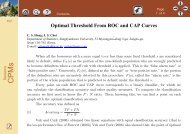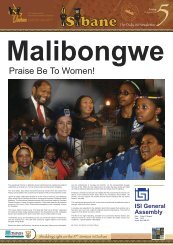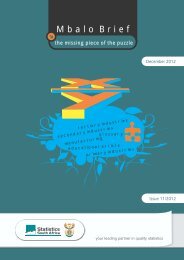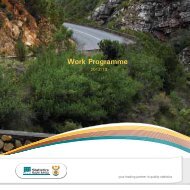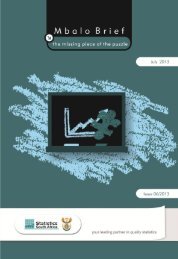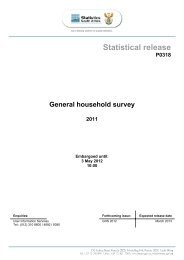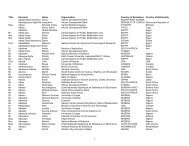Post-enumeration Survey (PES) - Statistics South Africa
Post-enumeration Survey (PES) - Statistics South Africa
Post-enumeration Survey (PES) - Statistics South Africa
You also want an ePaper? Increase the reach of your titles
YUMPU automatically turns print PDFs into web optimized ePapers that Google loves.
<strong>Statistics</strong> <strong>South</strong> <strong>Africa</strong><br />
11<br />
2.5 Fieldwork methodology<br />
The <strong>PES</strong> replicated the census in the sampled EAs, which meant that all methodologies and procedures<br />
for data collection were based on census methodologies and procedures. Extra measures were put in<br />
place to ensure that the <strong>PES</strong> conducted a more complete audit of the census, for example, extensive<br />
probing was conducted during the listing exercise in order to correctly identify and classify all structures<br />
and dwelling units, including the number of households and the number of persons per household. <strong>PES</strong><br />
fieldwork was split into the following three (3) phases; publicity and listing, <strong>enumeration</strong> and mop-up<br />
operations.<br />
• Publicity and listing were conducted at the same time. Publicity focused on informing and educating<br />
respondents and relevant stakeholders about the purpose of the <strong>PES</strong> to ensure successful<br />
coverage of all dwelling units (DUs) in selected EAs. Listing involved the recording of all structures<br />
(including all DUs, number of households in DUs and number of persons in households) in the<br />
sampled EAs in the EA Summary Books.<br />
• Enumeration involved interviewing respondents and recording responses in the fields provided in<br />
the <strong>PES</strong> questionnaire. Self-<strong>enumeration</strong> for the <strong>PES</strong> was discouraged, but was used in instances<br />
where the respondent insisted on self-<strong>enumeration</strong>.<br />
• Mop-up operations were conducted in the form of follow-up visits by senior field staff to households<br />
that could not be contacted during the <strong>enumeration</strong> period.<br />
Detailed instructions on data collection and other fieldwork procedures, e.g. concepts and definitions,<br />
lines of communication, quality assurance procedures, etc., were outlined in the manuals provided<br />
during training. The following manuals were developed for fieldwork purposes:<br />
• Census 2011 <strong>PES</strong> Logistics Manual (procedures for distribution and return of materials);<br />
• Census 2011 <strong>PES</strong> Fieldworker Manual (procedures for publicity, listing and data collection);<br />
• Census 2011 <strong>PES</strong> Fieldwork Supervisor Manual (procedures for supervision of staff and reporting);<br />
• Census 2011 <strong>PES</strong> District <strong>Survey</strong> Coordinator Manual (procedures for management and<br />
coordination of the survey at district level and reporting);<br />
• Census 2011 Map Reading Manual (guidelines on how to use maps);<br />
• Census 2011 <strong>PES</strong> Quality Assurance Manual (procedures on implementation of quality assurance<br />
measures);<br />
• Census 2011 <strong>PES</strong> Trainee Workbook on Publicity and Listing; and<br />
• Census 2011 <strong>PES</strong> Trainee Workbook on Enumeration.<br />
<strong>Post</strong> Enumeration <strong>Survey</strong> (<strong>PES</strong>)



